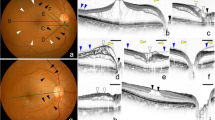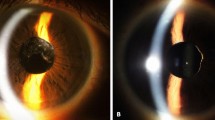Abstract
• Background: Diplopia after cataract surgery has been reported by several authors, but diplopia after recovery from vitreous hemorrhage (VH) has not been described. •Methods: We examined eight patients with manifest exotropia and binocular diplopia after recovery from dense VH by vitreous surgery. VH was bilateral in three patients and unilateral in five, and lasted for an average of 7.7 years. • Results: Visual acuity before vitrectomy ranged from 20/200 to light perception; that after vitrectomy ranged from 20/20 to 20/60. Exotropia was present in all patients after vitrectomy. Additionally, seven out of eight patients had vertical strabismus with an average deviation of 6 prism diopters (Δ). Fusion was confirmed in four patients with an average amplitude of 13 Δ. Four patients underwent horizontal strabismus surgery. Fusion was present in two before strabismus surgery and in all four after surgery; however, unstable diplopia persisted in three of the four after surgery. • Conclusion: Diplopia after vitrectomy for longstanding VH may occur due to fusion impairment comparable to that occasionally seen after surgery for traumatic cataract.
Similar content being viewed by others
References
Brent P (1986) Cataract patients: preoperative assessment for fusion potential. Am Orthopt J 36: 135–139
Catalano RA, Nelson LB, Calhoun JH (1987) Persistent strabismus presenting after cataract surgery. Ophthalmology 94: 491–494
Gruzensky WD, Palmer EA (1988) Intractable diplopia: a clinical perspective. Graefe's Arch Clin Exp Ophthalmol 226: 187–192
Hakin KN, Lee JP (1986) Binocular diplopai in unilateral aphakia: the role of Botulinum toxin. Eye 5: 447–450
Hamed LM (1991) Strabismus presenting after cataract surgery. Ophthalmology 98: 247–252
Hamed LM, Helveston EM, Ellis FD (1987) Persistent binocular diplopia after cataract surgery. Am J Ophthalmol 103: 741–744
Metz HS, Norris A (1987) Cyclotorsional diplopia following retinal detachment surgery. J Pediatr Ophthalmol Strabismus 24: 287–290
Pratt-Johnson JA, Tillson G (1979) Acquired central disruption of fusional amplitude. Ophthalmology 86: 2140–2142
Pratt-Johnson JA, Tillson G (1989) Intractable diplopia after vision in unilateral cataract. Am J Ophthalmol 107: 23–26
Author information
Authors and Affiliations
Rights and permissions
About this article
Cite this article
Fujikado, T., Ohmi, G., Ikeda, T. et al. Exotropia secondary to vitreous hemorrhage. Graefe's Arch Clin Exp Ophthalmol 235, 143–148 (1997). https://doi.org/10.1007/BF00941721
Received:
Accepted:
Issue Date:
DOI: https://doi.org/10.1007/BF00941721




